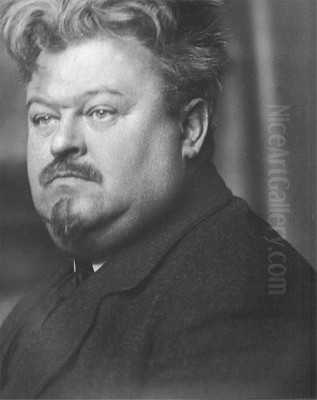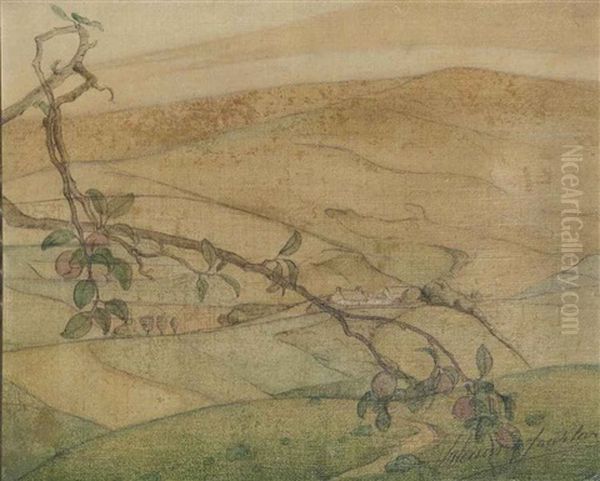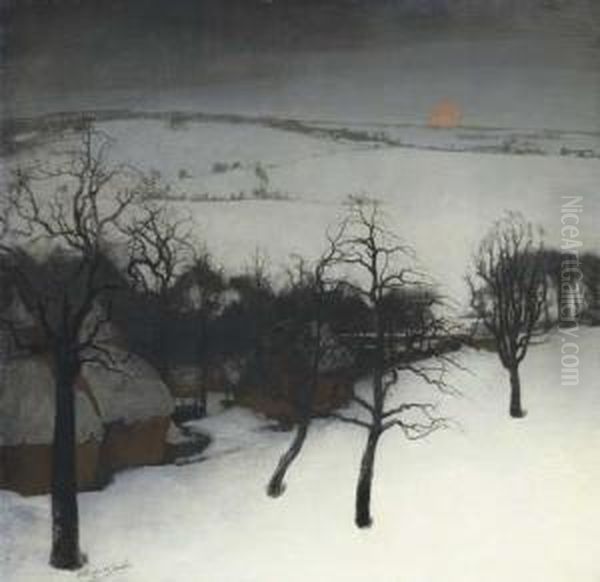
Valerius de Saedeleer stands as a significant figure in Belgian art history, primarily celebrated for his evocative landscape paintings. Born in Aalst, Belgium, in 1867, his life spanned a period of rich artistic development in Europe. De Saedeleer passed away on September 16, 1941, leaving behind a legacy deeply rooted in the Flemish landscape tradition yet infused with the spirit of Symbolism. His nationality was Belgian, and his artistic identity became intrinsically linked with the depiction of his homeland's natural beauty.
De Saedeleer's work is characterized by a profound connection to the landscapes of Flanders. He possessed a unique ability to capture the specific atmosphere and quiet majesty of the region. His paintings often feature the gentle curves of the Leie River or the broader vistas along the Escaut River, rendered with meticulous attention to detail and a deep sensitivity to the nuances of light and season. He was not merely painting topography; he was exploring the soul of the landscape.
Early Life and Artistic Formation
De Saedeleer's journey as an artist began with exposure to various influences. His early training and experiences shaped his technical skills and aesthetic sensibilities. While details of his formal education include time spent studying in Brussels, his development was also significantly marked by interactions with contemporary art movements and figures. The artistic environment of late 19th-century Belgium was vibrant, grappling with the legacy of Realism and the rise of Impressionism and Symbolism.
Initially, De Saedeleer's style showed leanings towards Impressionism. He was notably influenced by the work of François Courtens, a prominent Belgian landscape painter known for his realistic and light-filled depictions of nature. This early phase provided De Saedeleer with a strong foundation in capturing the fleeting effects of light and atmosphere, techniques associated with Impressionist practice. However, his artistic path would soon take a decisive turn towards a more introspective and symbolic mode of expression.

His life was marked by a degree of restlessness, leading him to live and work in various locations across Belgium, and even periods in France and the Netherlands. This peripatetic existence, while potentially enriching his experiences, also presented challenges in establishing a consistent artistic presence and reputation in his early career. It reflected a searching quality, perhaps both personal and artistic, that would eventually find a more settled focus in the artists' communities of Flanders.
The Latem Period: Symbolism and Collaboration
A pivotal moment in De Saedeleer's career occurred around 1898 when he settled in Sint-Martens-Latem, a village near Ghent that was becoming a haven for artists seeking tranquility and inspiration away from urban centers. This move proved crucial for his artistic development and placed him at the heart of a burgeoning creative community. It was here that he formed close friendships and artistic alliances with other key figures of Belgian Symbolism.
In Sint-Martens-Latem, De Saedeleer became associated with what is often referred to as the "First School of Latem" or sometimes the "Mystic School of Latem." This group shared a common interest in moving beyond mere surface representation towards exploring deeper spiritual, emotional, and symbolic meanings in their art. His closest associates during this period were the sculptor George Minne and the painter Gustave van de Woestyne.
The collaboration and mutual influence within this circle were profound. Minne's work, often featuring gaunt, introspective figures, resonated with the search for inner meaning, while Van de Woestyne explored portraiture and symbolic scenes with a similar depth. De Saedeleer contributed his unique focus on landscape, infusing his depictions of nature with the prevailing mood of mysticism and contemplation. They collectively sought an art that spoke to the soul, drawing inspiration from Flemish traditions but reinterpreting them through a modern, Symbolist lens. Another artist associated with the Latem group, though perhaps less central than Minne or Van de Woestyne, was Albijn Van den Abeele, whose work also reflected the local landscape and a certain quietude.
Artistic Style and Influences
Valerius de Saedeleer's mature artistic style is a distinctive blend of influences, synthesized into a unique personal vision. While rooted in the landscape genre, his work transcends simple representation, embodying key characteristics of Symbolism. He aimed to convey mood, spirituality, and the underlying essence or "soul" of the scenes he depicted, rather than just their external appearance. This often resulted in paintings imbued with a sense of stillness, mystery, and profound tranquility.

A significant influence on De Saedeleer was the rich heritage of early Netherlandish and Flemish painting. He held particular reverence for Pieter Bruegel the Elder, the 16th-century master renowned for his panoramic landscapes and depictions of peasant life, especially his winter scenes. De Saedeleer's own fascination with winter landscapes, often vast and snow-covered, clearly echoes Bruegel's compositions in their scope and atmospheric depth. This connection to tradition provided a historical anchor for his Symbolist explorations.
Despite moving towards Symbolism, traces of his earlier engagement with Impressionism remained, particularly in his sensitivity to light. His technique sometimes incorporated elements associated with Luminism, focusing on the effects of light and shadow to create atmosphere and emotional resonance. However, unlike the Impressionists' focus on capturing fleeting moments, De Saedeleer used light to enhance the timeless, spiritual quality of his scenes. His technical approach emphasized perfection and careful execution, often resulting in smooth surfaces and meticulously rendered details.
His compositions are often characterized by their simplicity and structure, featuring strong horizontal lines, panoramic views, and a sense of deep space. He frequently employed a cool color palette, dominated by blues, greys, whites, and muted earth tones, which contributed to the serene, sometimes melancholic, and contemplative mood of his work. Interestingly, De Saedeleer is known to have used photography as a tool, studying landscape compositions and details through photographs before translating them into his paintings, blending modern technology with traditional artistry. His contemporaries included figures like Emile Claus, a leading proponent of Belgian Luminism, and Frits van den Eijnden, showcasing the diverse artistic currents he navigated.
Key Themes and Subjects
The primary subject matter throughout Valerius de Saedeleer's career was the landscape of Flanders. He returned repeatedly to the familiar terrain of his homeland, finding endless inspiration in its fields, rivers, trees, and skies. His depictions were not generic; they often focused on specific locations, particularly the areas around the Leie and Escaut rivers, which he rendered with intimate knowledge and affection. These river landscapes became synonymous with his work.
Winter held a special fascination for De Saedeleer. He produced numerous winter scenes, capturing the stark beauty and profound silence of the Flemish countryside under snow. These paintings often feature wide, open vistas, skeletal trees etched against pale skies, and the soft, light-absorbing quality of snow. His winter landscapes are among his most celebrated works, showcasing his mastery of atmosphere and his ability to evoke a sense of stillness and introspection, heavily influenced by his admiration for Pieter Bruegel the Elder.

Beyond specific seasons or locations, a recurring theme in his work is the relationship between humanity and nature, though human figures are often absent or diminutive in his landscapes. The focus remains firmly on the enduring power and presence of the natural world. He explored the changing effects of light and seasons, using them not just for visual variety but as metaphors for deeper cycles of life, decay, and renewal. His landscapes often possess an abstract quality, simplifying forms and emphasizing structure to enhance their symbolic resonance.
Representative Works
Several paintings stand out as representative of Valerius de Saedeleer's artistic achievement and style. Among his most famous is Snow Landscape in Flanders. Often considered a pinnacle of his work, this painting exemplifies his mastery of the winter scene, capturing the quiet, expansive beauty of the snow-covered Flemish countryside with a blend of realism and profound stillness. Its composition and mood reflect the influence of Bruegel while being distinctly De Saedeleer's own. This work is now in the public domain, allowing for wide appreciation.
Another notable work is Coucher de soleil (Sunset). This painting likely depicts a scene along the Leie River, showcasing his skill in rendering the effects of light on water. Characterized by simplified lines and potentially brighter colors reflecting the sunset, it demonstrates his ability to capture the transient beauty of light while maintaining a sense of underlying tranquility. The reflection of sunlight on the water's surface would be a key element, handled with his typical sensitivity.
Other significant titles include The Row of Trees, which likely focuses on the strong vertical and horizontal elements that often structure his compositions, using trees as powerful forms within the landscape. Valley in Wales stems from his period of exile during World War I and represents his engagement with a different type of landscape, showcasing his adaptability while retaining his core stylistic concerns. Winter Landscape (or Paysage d'hiver) is a recurring theme, and one such work gained attention when it was sold at auction in London in 2017 for £17,000, indicating the continued market appreciation for his art. These works collectively illustrate his focus on landscape, his technical skill, and his Symbolist sensibility.
Exile During World War I
The outbreak of the First World War forced Valerius de Saedeleer, like many other Belgians, to seek refuge abroad. He and his family spent the war years in exile, primarily in the United Kingdom, including time spent in Wales. This period of displacement inevitably had an impact on his life and art. Removed from the familiar Flemish landscapes that had been his primary inspiration, he was confronted with new environments.
His time in Wales provided him with different scenery – more rugged and mountainous than the flatlands of Flanders. Works like Valley in Wales reflect this engagement with a new landscape. Sources suggest that during this period, De Saedeleer deepened his quest to capture not just the external appearance but the "inner soul" of the landscape. The experience of exile and the backdrop of the war may have intensified his introspective tendencies and his search for enduring meaning in nature.
Some interpretations suggest that De Saedeleer subtly incorporated the trauma and mood of the war years into his landscapes from this period. While not overtly depicting conflict, the atmosphere in some works might reflect a deeper sense of melancholy or contemplation influenced by the global events. Exploring themes of war's impact on nature and the human spirit through landscape was relatively uncommon at the time, adding another layer to his work from this era. This period demonstrates his resilience as an artist, continuing to create and evolve even amidst personal upheaval and unfamiliar surroundings.
Later Life and Legacy
After the end of World War I, Valerius de Saedeleer returned to Belgium. He continued to paint, settling in places like Etikhove and Leupegem. He remained dedicated to his vision of landscape painting, refining his style and continuing to produce works that captured the essence of the Flemish countryside. His reputation as a leading figure in Belgian art was solidified, and he was recognized as an important exponent of Symbolism and a master of landscape.
De Saedeleer's influence extended to the broader tradition of Flemish landscape painting. He successfully bridged the gap between the historical legacy of artists like Bruegel and the modern sensibilities of Symbolism and early Modernism. His unique synthesis of technical precision, atmospheric depth, and spiritual undertones offered a distinct path for landscape art in Belgium. He is considered one of the pioneers who revitalized the genre at the turn of the century. His interactions with artists like Léon De Smet further situated him within the active Belgian art scene of the time.
Today, Valerius de Saedeleer is remembered as a highly influential Belgian artist. His works are held in high esteem by museums, collectors, and art enthusiasts. They continue to be exhibited, allowing new generations to appreciate his unique vision. His paintings are valued not only for their aesthetic beauty but also for their profound sense of place and their quiet, contemplative power. He remains a key figure for understanding the development of Symbolism and landscape painting in Belgium around 1900. His contemporaries in the broader Belgian context included major figures like James Ensor, whose expressive and often fantastical work contrasts with De Saedeleer's quietude, and later Latem figures like Constant Permeke, who moved towards Expressionism.
Challenges and Controversies
Despite his eventual recognition, Valerius de Saedeleer's career was not without its challenges and points of discussion. His stylistic shift away from the Impressionist influence of François Courtens towards a more personal, Symbolist style in the 1890s was significant. At the time, this move might have been seen as somewhat radical or difficult to categorize, potentially leading to debate about his artistic direction among critics or the public accustomed to more traditional or purely Impressionistic landscapes.
His somewhat nomadic early life, moving between different towns and even countries, may have hindered the establishment of a stable career trajectory initially. While his time in Sint-Martens-Latem provided a crucial anchor, the earlier periods of movement reflect a potential struggle for consistent recognition or perhaps a personal restlessness that intertwined with his artistic search.
A more concrete controversy arose later, in the early 1980s, concerning the authenticity of certain works attributed to him. The appearance of questionable paintings necessitated expert intervention and court involvement to determine whether they were genuine De Saedeleer pieces. Specialists had to meticulously analyze style, brushwork, pigments, and signatures to verify authenticity. This situation highlights the value placed on his work in the art market but also underscores the potential for disputes regarding attribution for well-regarded artists.
Family Connections
Artistic inclinations were also present elsewhere in the De Saedeleer family. Valerius's sister, Elisabeth de Saedeleer, was herself involved in the arts, particularly in crafts and weaving. There were reportedly plans within the family to establish a weaving school, indicating a shared interest in artistic production and potentially in the revival of traditional crafts, which aligned with some aspects of the Arts and Crafts movement and Symbolist ideals of integrated art forms.
However, these plans for a family-run weaving school ultimately did not come to fruition. This anecdote offers a small glimpse into the broader artistic environment of the family and their aspirations, even if this particular venture faced obstacles. It suggests a familial engagement with creativity that extended beyond Valerius's own painting career, touching upon the applied arts as well.
Conclusion
Valerius de Saedeleer remains a pivotal figure in Belgian art, a master landscape painter whose work resonates with quiet power and deep feeling. His journey from Impressionist influences to becoming a key member of the Symbolist Latem school demonstrates a dedicated artistic search for meaning beyond surface appearances. His profound connection to the Flemish landscape, especially its winter moods and the gentle presence of its rivers, allowed him to create images that are both specific in their sense of place and universal in their contemplative appeal.
Influenced by the great Flemish masters like Pieter Bruegel the Elder, yet forging his own path alongside contemporaries like George Minne and Gustave van de Woestyne, De Saedeleer crafted a unique style. His meticulous technique, combined with a sensitivity to light and atmosphere, served his goal of revealing the inner spirit of the natural world. Despite challenges, including exile during wartime and later issues of authenticity surrounding his work, his artistic legacy endures. Valerius de Saedeleer's paintings continue to be admired for their technical brilliance, their serene beauty, and their enduring contribution to the rich tradition of European landscape art.